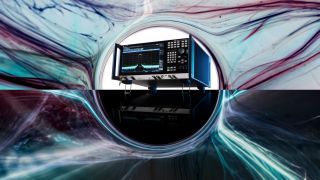How to measure phase noise
There are two types of instruments that can measure phase noise:
- Spectrum analyzers are the traditional tool for measuring phase noise. These are flexible, general-purpose instruments that can be used for a wide range of other measurements.
- Phase noise analyzers are specialized instruments for measuring phase noise. They usually have higher speed and sensitivity than traditional spectrum analyzers.
Measuring phase noise with a spectrum analyzer
Let’s start by looking at the spectrum analyzer method, since this will provide a better understanding of basic phase noise measurement concepts and results.
Spectrum analyzer or “direct spectrum” method:
- Measure the power of the carrier, i.e., the nominal oscillator output signal, as an absolute power in dBm.
- Move to a given frequency offset from the carrier and measure the noise power with a 1 Hz bandwidth.
- Subtract the carrier power from the noise power, and the result is phase noise in units of dBc per Hz.
Note that these values will always be negative. In almost all cases, this process is repeated at different frequency offsets from the carrier, and the results will usually be different at different offsets, generally decreasing the further away you get from the carrier.
In this example, the phase noise is measured at a positive frequency offset from the carrier. Since the “sidebands” created by phase noise are usually symmetrical around the carrier, the measured phase noise will be the same for a given positive and negative offset from the carrier. Here, the phase noise is is -70 dBc/Hz at both +10 kHz and -10 kHz offsets.
Therefore, phase noise is normally only measured on one side of the carrier, and this is called single sideband phase noise. By convention, positive offsets, or the upper sideband is used when measuring and reporting phase noise.
Single sideband phase noise is measured and plotted over a defined offset range. A logarithmic scale is used because it covers a wide frequency range and has finer resolution close to the carrier. Since phase noise is undesirable, lower values in our phase noise plot mean better phase noise performance.


















